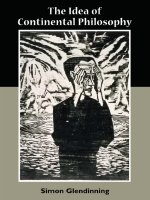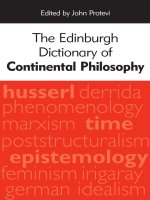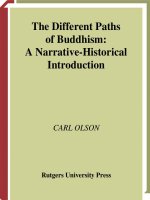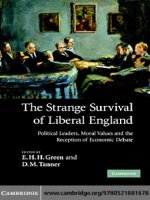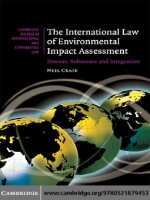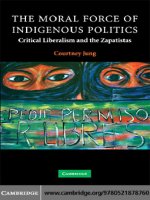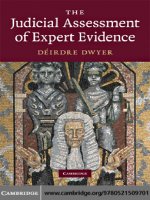edinburgh university press the edinburgh dictionary of continental philosophy jan 2006
Bạn đang xem bản rút gọn của tài liệu. Xem và tải ngay bản đầy đủ của tài liệu tại đây (2.2 MB, 641 trang )
deleuze
foucault
‘John Protevi has put together a very useful dictionary and I expect it to be used
extensively by students seeking clear and crisp definitions of key concepts, as well as
helpful and reliable accounts of the main intellectual figures, in continental philosophy.
The entries are uniformly excellent and Protevi’s grasp of the key concepts is first-rate.’
Keith Ansell Pearson, University of Warwick
‘The Edinburgh Dictionary of Continental Philosophy can be recommended to novices
and scholars alike because it satisfies the pressing need for a reliable guide to the most
recent developments in Continental philosophy not only in Europe, but also, and more
unusually, in North America.’
Professor Robert Bernasconi, Lillian and Morrie Moss Professor of Philosophy,
The University of Memphis
With over 450 clearly written definitions and articles by an international team of
specialists, this authoritative dictionary covers the thinkers, topics and technical terms
associated with the many fields known as ‘continental philosophy’. Special care has been
taken to explain the complex terminology of many continental thinkers. Researchers,
students and professional philosophers alike will find the dictionary an invaluable
reference tool.
Key features include:
• in-depth entries on major figures and topics
•over 190 shorter articles on other figures and topics
•over 250 items on technical terms used by continental thinkers, from ‘abjection’
[Kristeva] to ‘worldhood’ [Heidegger]
•coverage of related subjects that use continental terms and methods
•extensive cross-referencing, allowing readers to relate and pursue ideas in depth.
John Protevi is Associate Professor of French Studies at Louisiana State University. He is
the author of Time and Exteriority (Bucknell, 1994); Political Physics (Athlone, 2001); and
co-author, with Mark Bonta, of Deleuze and Geophilosophy (Edinburgh University Press,
2004). He is currently working on a book on ‘political physiology’ that will combine
cognitive science and poststructuralism.
Cover design: River Design, Edinburgh
Edinburgh University Press
22 George Square, Edinburgh EH8 9LF
www.eup.ed.ac.uk
ISBN 0 7486 1716 7
9 780748 617166
ISBN 0-7486-1716-7
The Edinburgh
Dictionary of
Continental Philosophy
Edited by John Protevi
Edited by John Protevi
derridahusserl
phenomenology
poststructuralism
epistemology
german idealism
feminism irigaray
marxism time
The Edinburgh Dictionary of
Continental Philosophy
The Edinburgh Dictionary of
Continental Philosophy
Edited by John Protevi
Edinburgh
The
Edinburgh Dictionary
of
Continental Philosophy
The
Edinburgh Dictionary
of
Continental Philosophy
Edited by John Protevi
Edinburgh University Press
# in this edition, Edinburgh University Press, 2005
# in the individual contributions is retained by the authors
Edinburgh University Press Ltd
22 George Square, Edinburgh
Typeset in 11 on 13 Ehrhardt
by Iolaire Typesetting, and
printed and bound in Great Britain by
Antony Rowe Ltd, Chippenham, Wilts
A CIP record for this book is available from the British Library
ISBN 0 7486 1715 9 (hardback)
ISBN 0 7486 1716 7 (paperback)
The right of the contributors
to be identified as authors of this work
has been asserted in accordance with
the Copyright, Designs and Patents Act 1988.
Contents
Preface vii
Entries A–Z 1
List of Contributors 619
Rationale for the present work
The Edinburgh Encyclopedia of Continental Philosophy (EECP) has
found a home among the leading reference works of various formats
(‘Readers’, ‘Companions’, ‘Histories’) now available for readers inter-
ested in continental philosophy. These works, consisting of large essays
(5–10,000 words) on major figures, movements and topics in the field,
serve certain purposes very well, but cannot serve all the needs of
readers interested in help with continental philosophy, in particular
those new to the field. Limited by the very size of the entries to a
restricted number of subject headings, these works are not as nimble or
user-friendly as they could be for quick orientation and as guides for
further study. For instance, a reader wanting a quick orientation on a
particular term used in continental circles (for example, ‘difference’)
must be able to associate that term with a particular author and then
wade through a long essay hoping for a discussion of it. And while that
discussion may provide cross-references to uses of the term in other
philosophers, it may again not do so. With the Edinburgh Dictionary of
Continental Philosophy (EDCP) we aim then to complement the EECP
by providing brief entries on a much wider range of subject headings.
Along with explicit cross-references, these mini-orientations will en-
able readers to quickly and accurately target their subsequent research
in the EECP and other resources.
Working definition of ‘continental philosophy’
‘Continental philosophy’ has always been an exceedingly difficult term
to define. In fact, it may even be impossible to define. After all,
Nietzsche tells us in On the Genealogy of Morals that ‘only that which
is without history can be defined’, and not only does continental
philosophy have a history, but most – although perhaps not all – of
viii preface
its practitioners would agree with Nietzsche that a historical treatment
(or what he would call a ‘genealogy’) of philosophical texts is vitally
important. Thus, in lieu of a definition, this Preface offers a
(synchronic) operational treatment and a (diachronic) genealogy of
continental philosophy.
By an operational treatment, we mean that we shall treat as con-
tinental those thinkers who are now or who have been at some time in
the past so labelled by a reasonable portion of the philosophical or
general intellectual community, whether or not that labelling consti-
tutes a set whose essence can be defined by a set of necessary and
sufficient conditions that demarcates it from other types of philosophy.
Indeed we will not even bind ourselves to what Wittgenstein would call
a family resemblance, since the fact that philosophers as diverse in aim,
method and style as Hegel and Nietzsche, Deleuze and Levinas,
Heidegger and Habermas, Irigaray and Gadamer, have all been called
continental philosophers would seem to strain even that generous way
of treating groups.
By a genealogy of continental philosophy we mean to trace not only
the history of the term, but also the various movements whose
convergence and divergence have made up the shifting field of con-
tinental philosophy over the years. First, what is the genealogy of the
term ‘continental philosophy’? As Simon Glendinning points out in his
article on Analytic Philosophy in the EDCP, it was first used as a term
of opprobrium by the Oxbridge philosophers of the 1950s for those ‘not
like us’, those over there on ‘the Continent’. Over the years ‘continental
philosophy’ has come to lose its geographical sense, however, due to the
strong interest in such a philosophy in the Anglophone world – it
makes little sense to call someone working with Derridean concepts in
North America, Australia (or indeed the United Kingdom or Ireland),
a ‘continental philosopher’ if that term is intended geographically! It
has also lost some but not all of its polemical sting when used in analytic
circles, and in fact it has come to be adopted as a positive self-
designation by many, as evidenced by the shift of the title of the
influential journal Man and World to its current Continental Philosophy
Review.
Second, the genealogy of the various convergent and divergent
movements of continental philosophy is often begun by citing a certain
appropriation of Kant and has come to include the philosophical and
intellectual movements of German Idealism, Marxism, phenomenol-
ogy, hermeneutics, existentialism, Frankfurt School Critical Theory,
that branch of feminism sometimes called ‘French feminism’, struc-
turalism and poststructuralism, the French ‘philosophy of difference’
preface ix
of the 1960s, philosophies based on or influenced by Freudian and
Lacanian psychoanalysis, and the multitude of subfields produced by
the intersections and mutual influences these movements have exerted
on each other.
Indeed the best reason for offering an operational and genealogical
treatment of continental philosophy rather than a definition of it lies in
precisely the sort of combinatorial explosion that results when these
movements are put into relation with one another. The resulting field
provides an ever-shifting profusion of positions, theses, methodologies
and so forth, no one of which can be said to unify the field. (The logic of
Derrida’s ‘quasi-transcendentality’ could be cited here: any term that
aspires to rise from an empirical field to a transcendental ordering or
conditioning position will leave behind it a mark of its absence from the
field.) Among the factors in the field of continental philosophy are:
(1) a reaction to the transcendental turn of Kant; (2) a materialist
‘overturning’ of Hegel; (3) the ‘overcoming of Platonism’; (4) a focus on
corporeality or embodiment, often combined with a focus on gender;
(5) a type of ‘linguistic turn’ via Saussure; (6) the disbelief in ‘grand
narratives’; (7) the structuralist or poststructuralist ‘death of the
subject’; (8) the philosophical implications of the ‘new sciences’
variously called catastrophe theory, chaos theory, or complexity theory;
and many other themes, almost all of which can be combined with each
other. For example, one could imagine a cross of the readings of
Deleuze and Guattari by Brian Massumi and Elizabeth Grosz as a
poststructuralist feminist appropriation of complexity theory to con-
sider gendered embodiment in globalised capitalism. Only a genealogy
considering multiple factors can offer ways to consider such a field; a
definition seeking to isolate an essence could only be arbitrary and
produce artificial distinctions. To twist Deleuze’s famous citation of
Spinoza: ‘we don’t know what the body [of continental philosophy] can
do’. An essential definition pretends to tell you what a body can do; a
genealogy only tells you what a body has done (although it may show
what it might do in the (near) future).
Using our operational and genealogical method, then, we will
attempt to cover in the EDCP the major figures, topics and technical
terms of the movements and themes sketched above. We begin our
treatment of philosophers with Kant and include contemporary figures
of note. The inclusion of figures presents difficult problems of judge-
ment, however, which we will illustrate with financial metaphors. With
regard to historical figures, we must balance the contemporary interest
in their work (their current ‘value’) with their historical importance, as
measured both by the highest point of interest in them at any one time
x preface
(their ‘peak price’) and by their ‘staying power’, the length of time they
sustained such interest. With contemporary figures we must balance
the current interest in their work against our best guesses as to the
future ‘worth’ of their philosophical ‘stock’. We have tried for a
reasonable depth in covering figures, but in certain cases we decided
not to commission an article on a figure in order to save room for
technical terms.
Format of entries and principle of selection
The EDCP consists of some 450 entries of limited size (a few reach
2,500 words for major figures, topics and movements, but most are
between 250 and 1,000 words). We took advantage of the specialised
knowledge of the commissioned authors in generating the list of
technical terms, on the principle that the distributed cognition of
experts would be far superior to the ability of any one generalist to
generate such a list of specialised terms.
In addition to figures clearly associated with continental philosophy,
we also treat (1) figures such as Freud and Saussure, who, while not
philosophers, have influenced many continental philosophers; (2)
Anglo-American philosophers or philosophical movements such as
Davidson, James and Rorty, or Pragmatism and Speech Act Theory,
where there is appreciable resonance with the work of continental
thinkers; (3) fields and movements such as Complexity Theory and
Semiotics, which, while not strictly speaking philosophical, are closely
linked to continental thinking; and (4) fields and movements such as
Cinema, Critical Legal Studies, Ecocriticism, Geography, Queer
Theory and Postcolonial Theory which have been influenced by
continental philosophy.
Target readership, aims and purpose of the work
We address the EDCP not only to professional philosophers who would
identify themselves as ‘continental’, but also to beginning students in
philosophy and other humanities disciplines, to professional philoso-
phers in the analytic tradition and to the educated lay public. We aim
for the EDCP to be a standard reference tool for the above readership.
It provides authoritative, accurate and objective (yet sympathetic)
treatments of thinkers, topics and technical terms in clear, jargon-free
language. As one of the foremost difficulties of continental philosophy
is the specialised terminology and complex writing style of many of
its figures, the articles in the EDCP will provide an encouraging
preface xi
introduction to the field for those at first intimidated by its difficulties.
But in providing this help, the articles will at the same time attempt to
explain what philosophical reasons led those thinkers to adopt those
terms and styles in the first place. Accuracy without jargon or para-
phrase and simplicity without superficiality or naivete
´
have been the
foremost editorial criteria.
Cross-referencing
We provide ‘See also’ references at the end of articles on figures to point
to articles devoted to technical terms associated with their work or to
point to where they are discussed in articles on movements or fields.
We do not do so in the reverse direction, that is from technical term
articles to major figures. In general, we do not provide references to
figures mentioned in an article on a movement or field.
Bibliography
Due to the size of the volume, there is no cumulative bibliography.
Bibliographical references are kept to a minimum in the articles, with
only the title (of the translation when available) and date of original
publication, as in: Being and Time (1927). We do not provide the date of
books in entries on technical terms, expect in certain cases, such as
when a comparison to other dates is made or when the book in question
is not mentioned in the article on the figure associated with that term.
The availability of bibliographic information via the Internet has, we
believe, obviated the need for including much of it in a work of this
kind.
Acknowledgements
The EDCP is truly a collaborative work. I’d like to thank the
contributors for their professionalism and expertise; the members of
the Editorial Advisory Board: Giovanna Borradori, Simon Glendin-
ning, Richard Kearney, Leonard Lawlor and Paul Patton for their
helpful advice at many stages of the project; Jackie Jones (who came
up with the idea for the EDCP in the first place), James Dale,
Anna Somerville, Carol Macdonald and all the people at Edinburgh
University Press for their good judgement and cheerful support; my
student workers Michael Roetzel, Souleymane Fofana, Janet Terry and
Sarah Lundmark and the clerical staff at the Department of French
Studies at Louisiana State University, Connie Simpson and Louise
xii preface
Lanier, for their hard work and patience with my endless requests for
paper, more paper; my colleagues in the Department of French Studies
for abiding my absent-mindedness while finishing this volume; and my
students, friends and teachers, who have all helped me grapple with
philosophy over the years. As I write these lines, I’m struck by the
impossibility of trying to thank my wife, without whose love and good
humour I would never have been up to this task. Finally, I’d like to
dedicate my work on this volume to Joseph J. Kockelmans, who first
introduced me to the study of continental philosophy at Penn State,
and whose generosity and wisdom has continued to inspire me in my
teaching and writing.
John Protevi
Baton Rouge, January 2005
The Dictionary
ABJECTION A notion developed by Kristeva in Powers of Horror
(1980), where she couples psychoanalysis with anthropological re-
search, in particular Mary Douglas’s analysis of defilement in Purity
and Danger (1969). Douglas maintains that defilement is defined and
ritualised in order to protect the borders of the body and society. As
Kristeva describes it, the abject is what is excluded in order to set up
the clean and proper boundaries of the body, the subject, the society or
nation. Above all, it is ambiguity that must be excluded or prohibited
so that identity can be stabilised. Bringing together Freud’s analysis of
the prohibition of incest with that of Le
´
vi-Strauss, Kristeva suggests
that ultimately the threatening ambiguity of the abject always comes
back to the maternal body, which must be excluded in order to
constitute and shore up both individual and social identity. Like all
repression, however, the abject maternal is bound to return, and its
return can be transformative or even revolutionary.
K. Oliver
ABSOLUTE One of the most crucial and yet very often misunderstood
terms in Hegel’s philosophy. In the Introduction to the Phenomenology
of Spirit, Hegel defines ‘the absolute’ simply as ‘whatever in truth is’.
This contrasts with mere appearances, semblances or half-truths.
Hegel’s ‘absolute’ is thus an expression of realism, of the view that
something exists and is whatever it is, regardless of whatever we say,
think or believe about it. This realism is consistent with Hegel’s
‘idealism’, because Hegel’s idealism is a moderate form of ontological
holism: the identity conditions of things are given by their causal
characteristics and by constitutive contrasts among their manifest
characteristics. Hence the identity conditions of things are mutually
interdependent. The only ontologically self-sufficient being is the
world-whole, which exists only in and through its various aspects or
constituents, namely particular objects, events or other specific phe-
nomena. Hegel contends that the world as a whole has a certain
discernable structure and historical telos, consisting in the gradual
development and achievement of human reason, knowledge and free-
dom. Through our collective, historically and socially based knowledge
of the world-whole to which we belong, the world-whole comes to
4 abstract machine
know itself. The world-whole is thus both substance – it is literally all
that does exist, has existed or will exist – and subject: through
humanity, the world-whole achieves self-knowledge and not only
facilitates but ultimately achieves rational freedom, embodied in
human communities.
In the Phenomenology of Spirit, the Philosophy of Right and in his
lectures on absolute spirit, Hegel contends that the modern world is
humanly intelligible and inhabitable, that it sufficiently facilitates our
individual and collective freedom, and that it thus deserves our
affirmation – and our cooperation in ongoing political and social
reform. Conversely, Hegel also tried to show that various forms of
alienation result mainly from failing to understand the modern world
and one’s place within it.
K. Westphal
ABSTRACT MACHINE A term used by Deleuze and Guattari in A
Thousand Plateaus to describe the most abstract level at which systems
assemble themselves. Both ‘abstract’ and ‘machine’ are terms of art.
‘Abstract’ has no connotation of conceptual generality, but should
rather be understood as being in proximity to the free creative
processes of production at the heart of the real. ‘Machinic’ also has
a specialised sense, designating processes that cannot be referred to
intentional control, and that therefore have only an oblique relation to
actual (technical) machines.
An abstract machine lies between the pure immanence of the flow of
matter and processes directly involved in the construction of a parti-
cular system, so-called machinic assemblages. Consequently, in an
abstract machine, matter is only partly formed or ‘intense’, prior to the
construction of any stable formed substances. In this intense state,
matter is neither passively waiting for forms to be impressed upon it,
nor is it simply a blindly surging chaos. Rather it is imbued with many
of the characteristics of fully constituted stable systems, but as ‘traits’
or embryonically. These traits actively probe for new creative poten-
tials or ‘becomings’ in ways that fully realised systems cannot (just as
embryos can fold and twist in ways organisms cannot).
Not all abstract machines generate novelty, however; there are also
abstract machines of stratification, which create hierarchies and stereo-
typed behaviour patterns.
A. Welchman
ABSURDITY (1) The quality of being deeply irrational. Modern
philosophical interest in the absurd can be traced back to Kierkegaard’s
active forgetting 5
interpretation of Abraham’s sacrifice in Fear and Trembling. That
Abraham was ready to sacrifice Isaac to God was not absurd, Kierke-
gaard argued. What was absurd was Abraham’s faith in the continuing
validity of God’s promise that through Isaac he would have many
descendants or, as Kierkegaard put it, that he would get Isaac back.
Abraham thus epitomises the ‘knight of faith’ who continually makes a
‘double-movement’ of renunciation and hope. How far Kierkegaard
himself is committed to such an absurdist view of faith is debatable,
although influential commentators such as the Russian existentialist
Lev Shestov (1866–1938) made it central to their portrayal of Kierke-
gaardian existentialism. For many in the twentieth-century, however,
the question of the absurd was no longer limited to exceptional
religious situations (such as Abraham’s), but belongs to life as such
and, for the modern consciousness at least, is unavoidable.
G. Pattison
ABSURDITY (2) The twentieth-century philosopher with whom the
notion of ‘the absurd’ is perhaps most closely associated is Albert
Camus. In The Myth of Sisyphus (1942), Camus identifies himself as an
‘absurdist’ by contrast with ‘existentialists’ such as Sartre – a contrast
that is usually not noticed or respected by many historians of philo-
sophy, who tend to classify Camus as himself an existentialist. For
Camus, ‘the absurd’ consists in the lack of fit, or congruence, between
the rational categories through which we think and the vast universe
which eludes all attempts at comprehensive explanation and justifica-
tion. Our existence, then, is ultimately absurd – an insight that Sartre
had already attributed to his protagonist, Roquentin, at the moment of
self-revelation which is the climax of Sartre’s early novel Nausea
(1938). In contrast to Sartre’s rather dismal portrayal of Roquentin,
Camus ends his essay with the famous line: ‘We must imagine Sisyphus
happy’; such happiness comes from the way Sisyphus accepts absurdity
and rejects any hope for a final fit of reason and world.
W. McBride
ACTIVE FORGETTING The process of corporeal re-attunement
Nietzsche recommends as a corrective to the asceticism that circum-
scribes the agency of modern subjects. In Essay II of On the Genealogy
of Morals, Nietzsche reverses the received wisdom of his day by
presenting memory as an unreliable, recently emergent faculty which
has been acquired at immeasurable cost to human beings. He describes
the forcible investiture of memory as involving a long, painful process,
which occupied much of human pre-history, culminating in the
6 actor-network theory
establishment of the ‘morality of mores’. The aim of this process, he
speculates, was to make human beings more regular and calculable, so
that they might receive the benefits and bear the responsibilities of life
in civil society.
Nietzsche concludes from this account of the acquisition of memory
that forgetting is actually more natural to human beings, even if
remembering has become our second nature. Rather than treat for-
getting as an inertial force or defect (whether moral or physiological),
he identifies it as ‘an active and in the strictest sense positive faculty of
repression’, which enables individuals to bypass consciousness as much
as possible in their absorption of adventitious experiences. He thus
identifies forgetting as essential to the creation of the ‘monological’
works of art that he most admires. Having ‘forgotten the world’, as he
puts it in Section 367 of The Gay Science, an artist may create without
regard for those ‘witnesses’ who may view and evaluate this creation.
Nietzsche occasionally suggests that a regimen of ‘active forgetting’
may enable (some) human beings to alter or suspend their participation
in the ascetic disciplines that define the agency of modern subjects. As
envisioned by Nietzsche, a regimen of ‘active forgetting’ thus involves a
deliberate undoing (or unlearning) of the ascetic routines that have
become second nature to us. Inasmuch as these routines have enforced
the self-division and self-estrangement that fault the agency of modern
subjects, a regimen of ‘active forgetting’ may succeed in recovering for
its practitioners a partial measure of self-possession and self-identity.
While a complete ‘return to nature’ (or recovery of a ‘second inno-
cence’) is simply out of the question, some human beings may be able
to ‘forget’ some aspects of their ascetic training, thereby granting
themselves novel opportunities for spontaneous displays of self-asser-
tion. Although a regimen of ‘active forgetting’ cannot absolve one of the
burden of one’s history, it may allow one to suffer this burden without
also suffering from it.
Our best example of the practice of ‘active forgetting’ may be
Nietzsche’s own Ecce Homo, in which he purports to explain ‘how
one becomes what one is’. In Ecce Homo, Nietzsche purports to
demonstrate how (and that) he has come to ‘forget’ so much of the
ascetic heritage that had stifled him earlier in his life, such that he may
now present himself as a world-historical ‘destiny’.
D. Conway
ACTOR-NETWORK THEORY (ANT) A research programme asso-
ciated with some Science and Technology Studies theorists during the
1980s to the mid-1990s; its theoretical death was announced in Actor
actual/virtual distinction 7
Network Theory and After (1999). The most notable ANT figures are
Madeleine Akrich, Michael Callon, Bruno Latour, John Law and
Antoine Hennion. They developed a critical vocabulary – ‘inscrip-
tions’, ‘regimes of delegation’, ‘the centrality of mediation’, ‘the
sociology of translation’ and ‘the enrolment of allies’ – that enabled
theorists to examine the production of technoscientific knowledge in its
varied, relational contexts.
Latour highlights two ideas as central to ANT. The first, a semiotics
of materiality, allows analysts to treat all entities – not just linguistic
ones – as being relationally constituted, as assuming temporary iden-
tities based upon associations with other ‘actants’. The second is a
methodological bracketing of all a priori classificatory categories; this
allows analysts, unencumbered by modern classifications of the natural
and the cultural, or the human and the non-human, to observe and
describe networks of heterogeneous association.
From a critical perspective, because ANT highlights the vast
infrastructure that enables technoscientific facts to be accepted as
authoritative, it can be understood as a methodological corrective to
traditional histories and theories of discovery that revolve around an
isolatable, heroic figure of genius. Despite the importance of this
narrative shift, a number of feminists and social theorists have criticised
ANT for its putative overemphasis on the Machiavellian aspects of
networking, that is for depicting scientists as using any available means
to establish centres of control.
E. Selinger
ACTUAL/VIRTUAL DISTINCTION A modal distinction proposed
by Deleuze as a replacement for the real–possible distinction, and as a
way of reformulating the relationship between the empirical and the
transcendental (the latter being the ‘ground’ or ‘condition’ of the
former). The concept of the possible is problematic in two ways.
We tend to think of the possible as pre-existing the real, and the real as
a possibility that has been instantiated in existence. But this process of
realisation is subject to two rules. On the one hand, since not every
possibility is realised, realisation involves a limitation by which some
possibles are supposed to be repulsed or thwarted, while others are
allowed pass into the real. On the other hand, the real is supposed to
resemble the possible it realises: the concept of the thing is already
given as possible, and simply has existence added to it when it is
realised, in a kind of brute leap. But this is where an illusion manifests
itself: if the real is supposed to resemble the possible, is it not because
we have retrospectively or retroactively ‘projected’ a fictitious image of
8 adestination
the real back into the possible? In other words, it is not the real that
resembles the possible, but the possible that resembles the real. The
possible thus fails as a transcendental or grounding concept because it
is simply traced off the empirical. The error, writes Deleuze in Logic of
Sense, ‘is to conceive of the transcendental in the image and resem-
blance of what it is supposed to found’.
Replacing the real–possible couplet with the actual–virtual couplet,
Deleuze argues in Difference and Repetition, is the only way to provide a
true concept of the transcendental field. For Deleuze, the virtual and
the actual correspond, but they do not resemble each other. A principle
of difference reigns throughout, with Deleuze marking the distinction
between virtual differentiation and actualisation as differenciation.
Virtual differentiation occurs via the composition of ‘multiplicities’
or ‘Ideas’, that is, sets of differential elements, differential relations and
singular points. The virtual differs from the actual, and the process of
actualisation does not proceed by limitation but by differenciation; the
virtual differs from itself in being actualised. The transcendental thus
no longer outlines the conditions of possible experience, but accounts
for the genesis of real experience: it forms an intrinsic genesis, not an
extrinsic conditioning. But to be a condition of real experience, the
condition can be no broader than what it conditions; the virtual must
therefore be determined along with the actual that it conditions, and it
must change as the conditioned changes (conditions are not universal
but singular). The search for new and actual concepts can be infinite,
since there is always an excess of the virtual that animates them (there
can therefore be no a priori categories, in the Kantian sense).
D. Smith
See also: transcendental empiricism
ADESTINATION A term used by Derrida to indicate the deconstruc-
tion of communication. When pronounced with its definite article, the
French word (l’adestination) is indistinguishable from its opposite
(la destination). It can therefore be understood as another version of
diffe
´
rance, but whereas the latter term intevenes most explicitly in the
concept of the sign, adestination effects the deconstruction of com-
munication. It is the necessary and irreducible structural possibility
that a letter can not arrive, built into the letter by means of its address
or posting, for once it is consigned to the postal system and to
uncontrollable mechanisms of delay, nothing can guarantee that it
will arrive. Only once it has arrived can it be said with certainty to
arrive.
Derrida develops the term in his debate with Lacan, who concludes
adorno, theodor 9
his analysis of Poe’s Purloined Letter with the assertion that a letter
always arrives at its destination (‘Le Facteur de la ve
´
rite
´
’inThe Post
Card). That assertion is for Derrida a sign of psychoanalysis’s recourse
to the truth of a transcendental signifier. In ‘Envois’ (The Post Card)he
performs adestination by writing postcards which are addressed to a
loved one but which are, as it were, purloined by the reader, and which,
by a complicated set of narrative effects, expose their precious contents
to the chance and destiny of the postal system.
D. Wills
ADORNO, THEODOR (1903–69) German philosopher and member
of the Frankfurt School, which attempted to connect Marxist theory
with investigations of present material conditions. Adorno t rained as
a classical pianist and composer and his earliest writings were in
music c riticism, a field always central to his concerns, though he
wrote on a range of issues in cultural studies, sociology, literary
criticism and philosophy. Shortly after Adorno joined the Institute
for Social Research at the University of Frankfurt, Hitler rose to
power and the Institute was sh ut down. Adorno then moved to
Oxford bef ore settling in America for the dura tion of The Sec ond
World War. After the war, he returned to Frankfurt, helping to
reconstitute the Institute and serving as its director during the last
years of his life.
These periods of exile and return were Adorno’s most productive:
during the former he wrote Dialectic of Enlightenment (with Hork-
heimer) (1944), a genealogical critique of subjectivity and instrumental
rationality, and Minima Moralia (1951), a melancholy assessment of the
damaged character of modern ‘private life’, which is asked to serve as
refuge from the societal structures that, in turn, distort it. During the
latter, Adorno composed Negative Dialectics (1966) and Aesthetic
Theory (1970), critical assessments of the cognitive character of,
respectively, philosophical reason and aesthetic judgement, as well
as the divide that has occurred between them.
Throughout all his works, Adorno traces, and subjects to critique,
the rise of ‘identity thinking’, the reduction of objects to instances of
general concepts. In this endeavour Adorno does not only produce a
history of thinking but, coinciding with Weber’s thesis of the ‘ratio-
nalisation’ and ‘disenchantment’ of the modern world, he also traces
the rise of a form of social organisation that renders individuals little
more than occasions for the application of abstracted, universal rules.
Rationality and society mirror and inform one another: reason is social
and society is, more or less, a product of reason. The tendency towards
10 adorno, theodor
societal rationalisation is exemplified by the ever-expanding centrality
of exchange value in capitalist society and culture, the subsumption of
the determinate qualities and uses of each thing and person to a
singular quantity (abstract labour time) that renders it indifferently
equivalent with every other. The ascendance of exchange value in
capitalism is, however, only an instance of a tendency endemic to the
development of rationality as such, which is driven by the imperative of
self-preservation to reduce the world to a system of general principles
that allow for control. In being directed towards overcoming fear,
liberating us from the fate of natural forces and ending suffering, such
identity thinking recoils upon human beings by reducing our material
singularity to the status of a ‘specimen’, an object of administration and
control. For Adorno, this reductive tendency unmasks such reason as
irrational and places it in an immanent relation to genocide, understood
as ‘absolute integration’.
Such rationality is not simply false – if it were, it would be useless for
the control of nature. Rather, it is the systematic drive to render nature
entirely determinable through a deductive order of concepts that
distorts reason (and the rational subject) and renders it incapable of
accounting for, and responding to, its own material ground in the
object and in experience. Indeed, the triumph of such reason, and of
the socio-historical world it expresses and informs, distorts experience,
both because rational structures come to shape individual engagement
with the world and because rationalised society shapes objects and
individuals. Embedded in, and constituted by, this history, no in-
dividual is free to simply live or think differently. Thus Adorno
continually insists that attempts to think outside the subject/object
opposition are misguided: the opposition is a socio-historical devel-
opment, one that is false but also real.
Rather than attempting an impossible escape, Adorno produces an
immanent critique of the products of modernity, revealing their
internal antagonisms and contradictions – the scars by which identity
thinking attests to its always incomplete effort to free itself from the
non-identical – as well as the suppressed hopes within such products
for another mode of life. Still, he does endeavour to articulate strategies
for a thinking that would not be identity-based, an effort that informs
his often difficult ‘paratactic’ manner of writing, in which the modes of
deductive argumentation are dispensed with in order to render a text in
which every claim is at an equal distance from its object. The negative
critique of concepts is also an effort to arrange concepts into
‘constellations’, a series of relations which is neither deductive nor
subsumptive, but which, clustered around a thing, might grasp its
aesthetic judgement 11
historical singularity, ‘the side which to a classifying procedure is either
a matter of indifference or a burden’.
What haunts this effort is the difficult dialectic of revolution: the
suspicion that no new manner of thinking could develop entirely
without a transformation of society, matched with the fear that any
revolution pursued under the present regime of thought will reproduce
terror. The position of art intimates this dilemma: as a form of
cognition grounded in the sensible and not guided by determinative
judgement, art inscribes the possibility of an alternative, reflective form
of knowledge and praxis. Yet the status of art in the modern world – a
sphere disconnected from and unable to influence the economic,
political and moral spheres wherein rationalisation holds sway –
renders art incapable of the social transformation toward which it
gestures. Art’s autonomy is the key to its persistence as a different
mode of knowledge and the source of its inability to be translated into
societal change. For Adorno, the position of dialectical philosophy, or
critical theory, is analogous to that of art: it holds open a small space of
freedom and hope precisely through its relentless practice of critique.
M. Bray
See also: Cinema; Critical Theory; dialectic of enlightenment;
Enlightenment; negative dialectics
AESTHETIC JUDGEMENT That form of judgement, examined by
Kant in his Critique of Judgement, which concerns beauty. In the
‘Transcendental Aesthetic’ of the Critique of Pure Reason Kant dis-
tinguished between aesthetic as a doctrine of ‘a priori sensibility’ and
the ‘critique of taste’. The aesthetic judgement belongs largely to the
latter, and is analysed in the first part of the Critique of Judgement. This
form of judgement has for Kant two fundamental peculiarities: it
involves the ascription of a quality (beauty) inseparable from a feeling
(pleasure), and is reflective, meaning that it does not apply a concept to
an object in the manner of the ‘determinate’ judgements analysed in the
first Critique but seeks out its concept by reflecting upon its acts of
judgement.
In the Analytic of the aesthetic judgement of taste Kant explores the
characteristics of such judgements in terms of the basic headings of the
table of the categories established in the first Critique, namely quality,
quantity, relation and modality. The quality of such judgements
consists in the absence of ‘interest’ – they are as indifferent to the
materiality as they are to the rational ideas informing their objects. The
quantity of such judgements consists in their ‘universal validity’, but
this universality is founded neither upon the subjective summing of
12 aesthetics
individual judgements nor on the universality of the concept. The
relation informing an aesthetic judgement consists in ‘purposiveness
without end’ that is neither the material structure of its object nor its
intelligible perfection. Finally, the modality proper to aesthetic judge-
ment is necessity, but not one based on ‘objective principles’.
Kant’s procedure with respect to the aesthetic judgement in the
third Critique is self-consciously aporetic – he devotes more attention to
describing what it is not rather than defining its positive qualities. The
searching and inconclusive character of the investigation extends to the
discussion of the deduction of such judgements and to their proximity
with the experience of the sublime. It has also contributed to the
intense discussion provoked by the aesthetic judgement which saw a
remarkable renaissance late in the twentieth century in the writings of
Arendt, de Man, Derrida and Lyotard.
H. Caygill
AESTHETICS That philosophical discipline which reflects on ques-
tions provoked by art works and artistic production, often – but not
always – in conjunction with the notion of ‘aesthetics’ as the realm of
the senses. One of the major works in continental aesthetics is
Heidegger’s ‘The Origin of the Work of Art’ (1936), which argues
that to understand art we must turn to actual works whose work-being
has been covered over by a language governed by the concepts of ‘form’
and ‘matter’, and by practices focused on the utility of objects detached
from their origins. Heidegger wants to show that the nature of art is to
be the truth of being setting itself to work in the work of art, the
unconcealedness of being, since whenever art happens, something is
brought out of nothing in a founding leap, opening a world and setting
it up on earth. Derrida counters in ‘Restitutions’ (in The Truth in
Painting, 1978) that the work of art is silent, meaningless, unless its
involvement in the world is disclosed in our pre-comprehension of the
world. A return to origins, to the pure presence of the object, would
require the erasure of all signs, memory and imagination. The most we
can accomplish is to capture the presence of a work as a representation,
with the result that the more we know of the world, the farther we are
from an understanding of the work of art as a pure origin. What is at
issue is the hold language has over what it describes in the work of art.
Wendy Steiner (The Colors of Rhetoric, 1982) describes this conflict as
one in which prose works engage the established linguistic signifying
system while visual arts emphasise the thingly nature of the work of art,
yet the language system defines both.
Lyotard points out in The Postmodern Condition (1979) that thought
